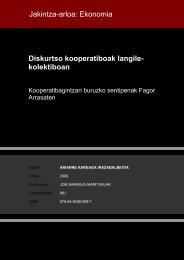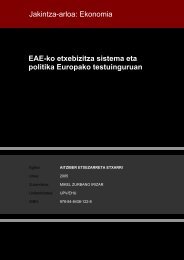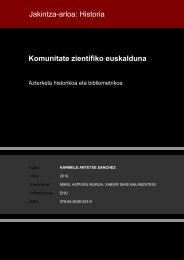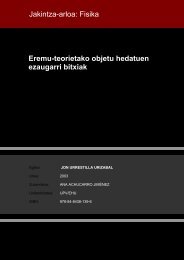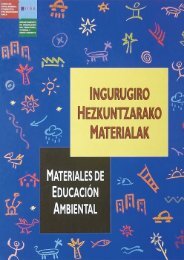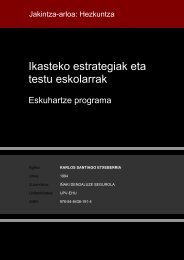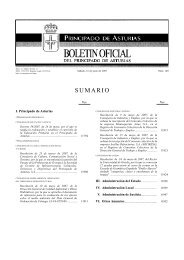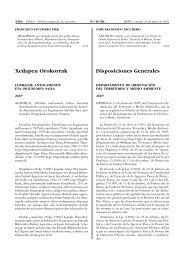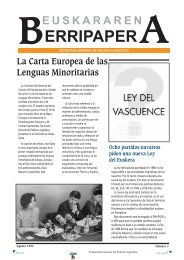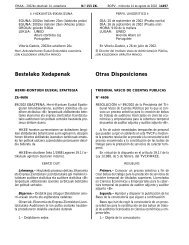Sinterizazio-atmosferaren eragina M graduko (ASP 30 ... - Euskara
Sinterizazio-atmosferaren eragina M graduko (ASP 30 ... - Euskara
Sinterizazio-atmosferaren eragina M graduko (ASP 30 ... - Euskara
You also want an ePaper? Increase the reach of your titles
YUMPU automatically turns print PDFs into web optimized ePapers that Google loves.
Metallographic changes during sintering of<br />
grade M high speed steels in industrial<br />
atmosphere and vacuum<br />
I. Urrutibeaskoa, R . Palma, V . Martínez, and J . J. Urcola<br />
The metallographic changes taking place in four M<br />
grade steels, M3/2, Px<strong>30</strong> (a Powdrex SA water<br />
atomised powder equivalent to <strong>ASP</strong> <strong>30</strong>), M2, and<br />
M42, during sintering at the optimum temperature<br />
and oversintering in vacuum and in a nitrogen based<br />
industrial atmosphere have been investigated using<br />
SEM and EDS techniques . M6C and MC primary<br />
carbides were observed after vacuum sintering and<br />
MX carbonitrides instead of MC carbides were<br />
found in the specimens sintered in the industrial<br />
atmosphere . Small amounts of a eutectic carbide<br />
rich in Cr and Fe were observed at the optimum<br />
sintering temperature . On oversintering in vacuum<br />
different types of eutectic carbides were observed -<br />
MC, needle shape, and M 6C - but MC type eutectic<br />
carbides were not observed on oversintering the<br />
samples in the industrial atmosphere . PM/0535<br />
©1990 The Institute of Metals . Manuscript received 9 July<br />
1990 ; in final form 9 October 1990 . Dr Urrutibeaskoa,<br />
Dr Palma, and Dr Martínez are in the Escuela Superior de<br />
Ingenieros Industriales, Universidad de Navarra, San<br />
Sebastián, Spain . Dr Urcola is in the Centro de Estudios e<br />
Investigaciones Técnicas de Guipuzcoa, San Sebastián,<br />
Spain .<br />
Work carried out in the past 20 years on the sintering of<br />
high speed steels (HSS) has allowed the development of<br />
appropriate routes for the fabrication of HSS, which are<br />
now well established .' -' Although it is well known that<br />
direct sintering is through a supersolidus mechanism, 8-10<br />
details of the different phases and carbides forming in such<br />
a process are not entirely clear . Several carbides (M 6 C,<br />
M2C, MC, M23C6i and M 3 C) found at room temperature<br />
after sintering are assumed to form in the sintering process<br />
. Two steels, T42'' 11 .12 and M2, '3 sintered in vacuum<br />
have been studied in depth . In the present work, which<br />
forms part of an extended programme studying the<br />
influence of the sintering atmosphere on the microstructure<br />
and the mechanical properties of several directly<br />
sintered HSS, the metallographic changes taking place<br />
when sintering M grade steels in vacuum and in nitrogen<br />
based industrial atmosphere are analysed .<br />
EXPERIMENTAL PROCEDURE<br />
Annealed water atomised powders, with and without the<br />
addition of 0 .2% of elemental carbon in the form of<br />
graphite, were cold compacted uniaxially at a pressure of<br />
500 MPa . This resulted in green densities of 67-70%<br />
theoretical density . The compacts were sintered either in a<br />
flowing industrial atmosphere of composition<br />
90N29H2-1CH4 or under a vacuum better than 5 x<br />
10 - ' Pa . The samples were heated to the sintering temperature<br />
at a mean rate of 50 K min' and soaked for 45 min .<br />
Specimens were then cooled at a rate of 250 K min' . The<br />
sintered samples were sectioned and prepared according<br />
to standard metallographic techniques . Specimens in the<br />
as polished (with a 1 µm diamond) condition were<br />
observed in a 501B Philips scanning electron microscope,<br />
fitted with an EDAX9100 energy dispersive X-ray system<br />
used to analyse the different carbides .<br />
RESULTS<br />
M3/2 steel<br />
Figure 1 shows typical SEM micrographs at the optimum<br />
sintering temperature for M3/2+0 .2%C steel sintered in<br />
the gas atmosphere and in vacuum . (Analyses of the<br />
metallic elements present in the various constituents<br />
observed are given below all micrographs .) The grey MC<br />
carbides, rich in V, observed in the vacuum sintered<br />
specimens are substituted by the small black, square MX<br />
carbonitrides, richer in V than the MC carbides . In both<br />
micrographs the bright, rectangular M6 C carbides, rich in<br />
W and Mo, are similar in appearance with almost the same<br />
chemical composition . On increasing the sintering temperature<br />
eutectic carbides tend to form (Fig . 2) . The following<br />
eutectic carbides types are observed :<br />
(i) eutectic carbide, present in small amounts in all<br />
the samples at the optimum sintering temperature<br />
(type I)<br />
(ii) eutectic carbide type MC, present only in vacuum<br />
sintered specimens, with composition and contrast<br />
close to MC primary carbides<br />
(iii) eutectic carbide type M 6C, similar in composition and<br />
contrast to M6C carbide, with a clear dendritic shape<br />
(iv) needle shaped carbide, found only in vacuum sintered<br />
specimens after gross oversintering .<br />
It is worth emphasising that eutectic carbides type I and<br />
type M 6 C show the same composition whether the specimens<br />
are sintered in vacuum or in an industrial atmosphere<br />
and that MC type and needle type eutectic carbides<br />
are observed only in vacuum sintered specimens and not in<br />
those sintered in the industrial atmosphere . On the other<br />
hand type I eutectic carbides are observed in both materials<br />
at the optimum sintering temperature, MC type<br />
eutectic carbides after only 10 K oversintering in vacuum,<br />
M6C type eutectic carbides after 20 K oversintering in<br />
vacuum and <strong>30</strong> K in the industrial atmosphere, and needle<br />
type after 25-<strong>30</strong> K oversintering in vacuum .<br />
Px<strong>30</strong> steel<br />
Figure 3 shows two typical SEM micrographs of a Px<strong>30</strong><br />
steel sintered at the optimum sintering temperature in<br />
vacuum and in the industrial atmosphere . It is obvious that<br />
the M6C carbides have almost the same appearance and<br />
composition independent of the sintering media used,<br />
vacuum or industrial atmosphere (except in the minor<br />
Powder Metallurgy 1990 Vol . 33 No . 4 <strong>30</strong>5



